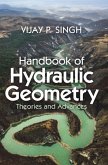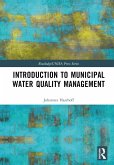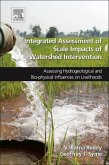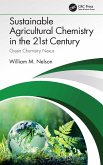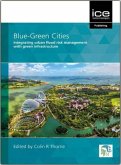Patrick L. Brezonik ( Professor Emeritus in the Department of Civil, William A. Arnold (Distinguished McKnight University and Joseph T.
Water Chemistry
The Chemical Processes and Composition of Natural and Engineered Aquatic Systems
Patrick L. Brezonik ( Professor Emeritus in the Department of Civil, William A. Arnold (Distinguished McKnight University and Joseph T.
Water Chemistry
The Chemical Processes and Composition of Natural and Engineered Aquatic Systems
- Broschiertes Buch
- Merkliste
- Auf die Merkliste
- Bewerten Bewerten
- Teilen
- Produkt teilen
- Produkterinnerung
- Produkterinnerung
Water Chemistry provides students with the tools necessary to understand the processes that control the chemical species present in waters of both natural and engineered systems. After providing basic information about water and its chemical composition in environmental systems, the text covers the theory and background material necessary to solve problems.
Andere Kunden interessierten sich auch für
![Handbook of Hydraulic Geometry Handbook of Hydraulic Geometry]() Vijay P. Singh (Texas A & M University)Handbook of Hydraulic Geometry85,99 €
Vijay P. Singh (Texas A & M University)Handbook of Hydraulic Geometry85,99 €![Introduction to Municipal Water Quality Management Introduction to Municipal Water Quality Management]() Johannes HaarhoffIntroduction to Municipal Water Quality Management126,99 €
Johannes HaarhoffIntroduction to Municipal Water Quality Management126,99 €![Integrated Assessment of Scale Impacts of Watershed Intervention Integrated Assessment of Scale Impacts of Watershed Intervention]() V. Ratna ReddyIntegrated Assessment of Scale Impacts of Watershed Intervention105,99 €
V. Ratna ReddyIntegrated Assessment of Scale Impacts of Watershed Intervention105,99 €![Sustainable Agricultural Chemistry in the 21st Century Sustainable Agricultural Chemistry in the 21st Century]() William Nelson (USA University of Illinois)Sustainable Agricultural Chemistry in the 21st Century107,99 €
William Nelson (USA University of Illinois)Sustainable Agricultural Chemistry in the 21st Century107,99 €![Integrated Flood Risk Management Integrated Flood Risk Management]() Kuniyoshi Takeuchi (Japan University of Yamanashi)Integrated Flood Risk Management110,99 €
Kuniyoshi Takeuchi (Japan University of Yamanashi)Integrated Flood Risk Management110,99 €![Blue-Green Cities Blue-Green Cities]() Colin ThorneBlue-Green Cities102,99 €
Colin ThorneBlue-Green Cities102,99 €![Nanoparticles as Sustainable Environmental Remediation Agents Nanoparticles as Sustainable Environmental Remediation Agents]() Nanoparticles as Sustainable Environmental Remediation Agents246,99 €
Nanoparticles as Sustainable Environmental Remediation Agents246,99 €-
-
-
Water Chemistry provides students with the tools necessary to understand the processes that control the chemical species present in waters of both natural and engineered systems. After providing basic information about water and its chemical composition in environmental systems, the text covers the theory and background material necessary to solve problems.
Hinweis: Dieser Artikel kann nur an eine deutsche Lieferadresse ausgeliefert werden.
Hinweis: Dieser Artikel kann nur an eine deutsche Lieferadresse ausgeliefert werden.
Produktdetails
- Produktdetails
- Verlag: Oxford University Press Inc
- 2 Revised edition
- Seitenzahl: 976
- Erscheinungstermin: 30. September 2022
- Englisch
- Abmessung: 237mm x 153mm x 61mm
- Gewicht: 1658g
- ISBN-13: 9780197651896
- ISBN-10: 0197651895
- Artikelnr.: 65951637
- Herstellerkennzeichnung
- Libri GmbH
- Europaallee 1
- 36244 Bad Hersfeld
- gpsr@libri.de
- Verlag: Oxford University Press Inc
- 2 Revised edition
- Seitenzahl: 976
- Erscheinungstermin: 30. September 2022
- Englisch
- Abmessung: 237mm x 153mm x 61mm
- Gewicht: 1658g
- ISBN-13: 9780197651896
- ISBN-10: 0197651895
- Artikelnr.: 65951637
- Herstellerkennzeichnung
- Libri GmbH
- Europaallee 1
- 36244 Bad Hersfeld
- gpsr@libri.de
Patrick L. Brezonik is Professor Emeritus in the Department of Civil, Environmental, and Geo- Engineering at the University of Minnesota. His research interests have included various surface water quality issues, nutrient chemistry, natural organic matter, and applications of satellite imagery to analyze large-scale patterns in surface water quality. William A. Arnold is the Distinguished McKnight University and Joseph T. Rose S. Ling Professor in the Department of Civil, Environmental, and Geo- Engineering at the University of Minnesota. His research interests include transformation and remediation of anthropogenic chemicals in the environment, photochemistry, and surface-mediated redox processes.
* Preface
* Acknowledgments
* Symbols and Acronyms
* Symbols
* Acronyms
* Units for physical quantities
* Important constants
* Conversion Factors
* Energy-related quantities
* Pressure
* Some useful relationships
* Part I. Prologue
* 1 Introductory matters
* 2 Aqueous geochemistry I: Inorganic chemical composition of natural
waters
* Part II. Theory, Fundamentals, and Important Tools
* 3 The thermodynamic basis for equilibrium chemistry
* 4 Activity-concentration relationships
* 5 Fundamentals of chemical kinetics
* 6 Fundamentals of organic chemistry for environmental systems
* Part III. Chemical Equilibria and Kinetics
* 7 Principles of acid-base equilibria
* 8 Solving acid-base equilibria and the carbonate system
* 9 Complexation reactions and metal ion speciation
* 10 Solubility: Reactions of solid phases with water
* 11 Redox equilibria and kinetics
* 12 Surface chemistry and sorption
* 13 Partitioning and chemical transformations of organic contaminants
* Part IV. Chemistry of Natural Waters and Engineered Systems
* 14 Fundamentals of photochemistry and some applications in aquatic
systems
* 15 Chemistry of chlorine and other oxidants/disinfectants
* 16 Aqueous geochemistry II: Provenance, weathering, and landscape
models for natural waters
* 17 The minor elements: Fe, Mn, Al
* 18 Dissolved oxygen
* 19 Nutrient cycles and the chemistry of nitrogen and phosphorus
* 20 Natural organic matter
* Appendix: Free energies and enthalpies of formation of common
* chemical species
* Index
* Acknowledgments
* Symbols and Acronyms
* Symbols
* Acronyms
* Units for physical quantities
* Important constants
* Conversion Factors
* Energy-related quantities
* Pressure
* Some useful relationships
* Part I. Prologue
* 1 Introductory matters
* 2 Aqueous geochemistry I: Inorganic chemical composition of natural
waters
* Part II. Theory, Fundamentals, and Important Tools
* 3 The thermodynamic basis for equilibrium chemistry
* 4 Activity-concentration relationships
* 5 Fundamentals of chemical kinetics
* 6 Fundamentals of organic chemistry for environmental systems
* Part III. Chemical Equilibria and Kinetics
* 7 Principles of acid-base equilibria
* 8 Solving acid-base equilibria and the carbonate system
* 9 Complexation reactions and metal ion speciation
* 10 Solubility: Reactions of solid phases with water
* 11 Redox equilibria and kinetics
* 12 Surface chemistry and sorption
* 13 Partitioning and chemical transformations of organic contaminants
* Part IV. Chemistry of Natural Waters and Engineered Systems
* 14 Fundamentals of photochemistry and some applications in aquatic
systems
* 15 Chemistry of chlorine and other oxidants/disinfectants
* 16 Aqueous geochemistry II: Provenance, weathering, and landscape
models for natural waters
* 17 The minor elements: Fe, Mn, Al
* 18 Dissolved oxygen
* 19 Nutrient cycles and the chemistry of nitrogen and phosphorus
* 20 Natural organic matter
* Appendix: Free energies and enthalpies of formation of common
* chemical species
* Index
* Preface
* Acknowledgments
* Symbols and Acronyms
* Symbols
* Acronyms
* Units for physical quantities
* Important constants
* Conversion Factors
* Energy-related quantities
* Pressure
* Some useful relationships
* Part I. Prologue
* 1 Introductory matters
* 2 Aqueous geochemistry I: Inorganic chemical composition of natural
waters
* Part II. Theory, Fundamentals, and Important Tools
* 3 The thermodynamic basis for equilibrium chemistry
* 4 Activity-concentration relationships
* 5 Fundamentals of chemical kinetics
* 6 Fundamentals of organic chemistry for environmental systems
* Part III. Chemical Equilibria and Kinetics
* 7 Principles of acid-base equilibria
* 8 Solving acid-base equilibria and the carbonate system
* 9 Complexation reactions and metal ion speciation
* 10 Solubility: Reactions of solid phases with water
* 11 Redox equilibria and kinetics
* 12 Surface chemistry and sorption
* 13 Partitioning and chemical transformations of organic contaminants
* Part IV. Chemistry of Natural Waters and Engineered Systems
* 14 Fundamentals of photochemistry and some applications in aquatic
systems
* 15 Chemistry of chlorine and other oxidants/disinfectants
* 16 Aqueous geochemistry II: Provenance, weathering, and landscape
models for natural waters
* 17 The minor elements: Fe, Mn, Al
* 18 Dissolved oxygen
* 19 Nutrient cycles and the chemistry of nitrogen and phosphorus
* 20 Natural organic matter
* Appendix: Free energies and enthalpies of formation of common
* chemical species
* Index
* Acknowledgments
* Symbols and Acronyms
* Symbols
* Acronyms
* Units for physical quantities
* Important constants
* Conversion Factors
* Energy-related quantities
* Pressure
* Some useful relationships
* Part I. Prologue
* 1 Introductory matters
* 2 Aqueous geochemistry I: Inorganic chemical composition of natural
waters
* Part II. Theory, Fundamentals, and Important Tools
* 3 The thermodynamic basis for equilibrium chemistry
* 4 Activity-concentration relationships
* 5 Fundamentals of chemical kinetics
* 6 Fundamentals of organic chemistry for environmental systems
* Part III. Chemical Equilibria and Kinetics
* 7 Principles of acid-base equilibria
* 8 Solving acid-base equilibria and the carbonate system
* 9 Complexation reactions and metal ion speciation
* 10 Solubility: Reactions of solid phases with water
* 11 Redox equilibria and kinetics
* 12 Surface chemistry and sorption
* 13 Partitioning and chemical transformations of organic contaminants
* Part IV. Chemistry of Natural Waters and Engineered Systems
* 14 Fundamentals of photochemistry and some applications in aquatic
systems
* 15 Chemistry of chlorine and other oxidants/disinfectants
* 16 Aqueous geochemistry II: Provenance, weathering, and landscape
models for natural waters
* 17 The minor elements: Fe, Mn, Al
* 18 Dissolved oxygen
* 19 Nutrient cycles and the chemistry of nitrogen and phosphorus
* 20 Natural organic matter
* Appendix: Free energies and enthalpies of formation of common
* chemical species
* Index


